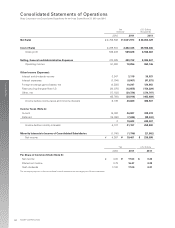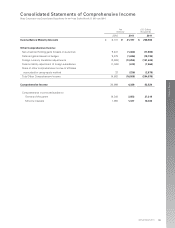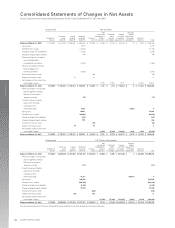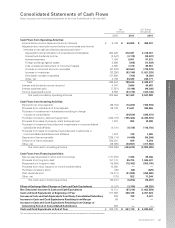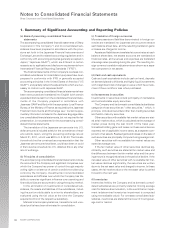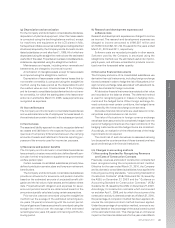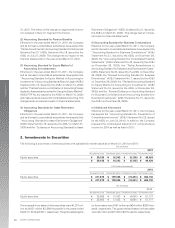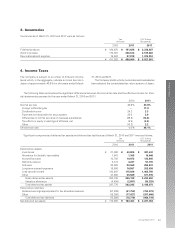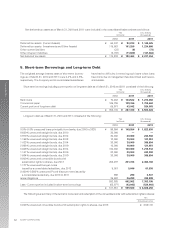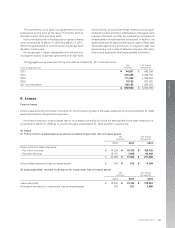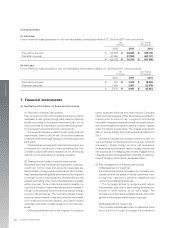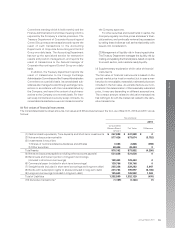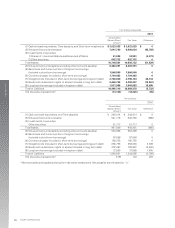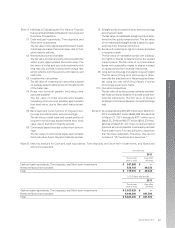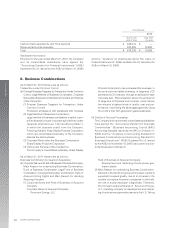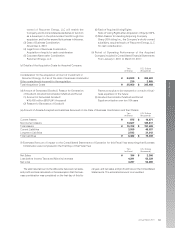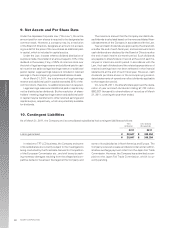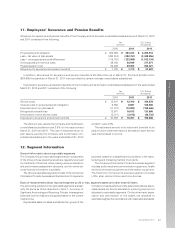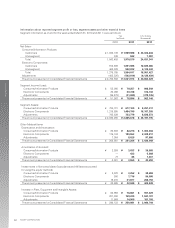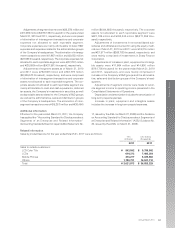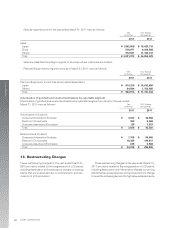Sharp 2011 Annual Report Download - page 56
Download and view the complete annual report
Please find page 56 of the 2011 Sharp annual report below. You can navigate through the pages in the report by either clicking on the pages listed below, or by using the keyword search tool below to find specific information within the annual report.
54 SHARP CORPORATION
Financial Section
Due within one year
Due after one year
2011
Yen
(millions)
2010
¥ 23,676
41,456
¥ 65,132
2011
¥ 36,883
37,860
¥ 74,743
$ 449,793
461,707
$ 911,500
U.S. Dollars
(thousands)
(a) As lessee
Future minimum lease payments for only non-cancelable contracts as of March 31, 2010 and 2011 were as follows:
Due within one year
Due after one year
2011
Yen
(millions)
2010
¥831
1,641
¥ 2,472
2011
¥ 1,520
1,961
¥ 3,481
$ 18,536
23,915
$ 42,451
U.S. Dollars
(thousands)
(b) As lessor
Future minimum lease receipts for only non-cancelable contracts as of March 31, 2010 and 2011 were as follows:
Operating leases
7. Financial Instruments
(a) Qualitative information on financial instruments
(1) Policies for financial instruments
The Company and its consolidated subsidiaries obtain
necessary funds, mainly through bank loans and issuing
bonds, according to its capital investment plan, for its
main business of manufacturing and distributing elec-
tronics equipment and electronic components.
Any surplus funds are invested in high quality financial
instruments, deem to be low risk. Short-term operating
funds are obtained through issuing commercial paper and
bank loans.
Transactions involving such financial instruments are
conducted with creditworthy financial institutions. The
Company utilizes derivative transactions for minimizing
risk and not for speculative or dealing purposes.
(2) Description and risks of financial instruments
Notes and accounts receivable are exposed to customer
credit risk. Some notes and accounts receivable are
denominated in foreign currencies because the Company
has business relations globally and therefore are exposed
to foreign currency risk exposures. Notes and accounts
payable (excluding other accounts payable) are payable
within one year. Some notes and accounts payable ris-
ing from the import of raw materials are denominated in
foreign currencies and therefore are exposed to foreign
currency risk exposures. The Company offsets foreign
currency denominated notes and accounts receivable
with notes and accounts payable, and uses forward
exchange contracts to hedge foreign currency risk expo-
sures.
Other securities are held for the long term to construct
better business alliances and relations with Company
customers and suppliers. Other securities are exposed to
market price fluctuation risk. Long-term borrowings
(included in long-term debt) and bonds (included in short-
term borrowings and long-term debt) are mainly in prepa-
ration for capital investments. The longest redemption
date of bonds is eight and a half years after March 31,
2011.
Derivative transactions consist primarily include for-
ward exchange contracts and currency swap contracts
are used to hedge foreign currency risk exposures.
Interest swap contracts are used to hedge interest rate
risk exposures. For hedging instruments, hedged items,
hedging policies and assessment methods of effective-
ness of hedging instruments, please see Note 1.
(3) Risk management of financial instruments
[1] Management of credit risk
For notes and accounts receivable, the Company peri-
odically reviews the status of its key customers, mon-
itoring their respective payment deadlines and
remaining outstanding balances.
The Company strives to recognize and reduce
irrecoverable risks, due to deteriorating financial con-
ditions or other factors, at an early stage. The
Company’s consolidated subsidiaries also follow the
same monitoring and administration process.
[2] Management of market risk
The Company decides basic policy for derivative trans-
actions at the Foreign Exchange Administration


